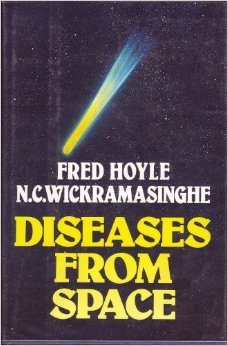Diseases from Space
Topic: Astronomy
 From HandWiki - Reading time: 3 min
From HandWiki - Reading time: 3 min
 | |
| Author | Chandra Wickramasinghe, Fred Hoyle |
|---|---|
| Country | United Kingdom |
| Language | English |
| Genre | Space medicine |
| Published | 1979 |
| ISBN | ISBN:978-0060119379 |
| LC Class | RC1137 |
Diseases from Space is a book published in 1979 that was authored by astronomers Fred Hoyle and Chandra Wickramasinghe, where they propose that many of the most common diseases which afflict humanity, such as influenza, the common cold and whooping cough, have their origins in extraterrestrial sources. The two authors argue the case for outer space being the main source for these pathogens or at least their causative agents.[1][2][3]
The claim connecting terrestrial disease and extraterrestrial pathogens was rejected by the scientific community.
Overview
Fred Hoyle and Chandra Wickramasinghe spent over 20 years investigating the nature and composition of interstellar dust. Though many hypotheses regarding this dust had been postulated by various astronomers since the middle of the 19th century, all were found to be wanting as and when new data on the gas and dust clouds became available. Chandra Wickramasinghe proposed the existence of polymeric composition based on the molecule formaldehyde (H2CO).[4]
In 1974 Wickramasinghe first proposed the hypothesis that some dust in interstellar space was largely organic (containing carbon and nitrogen),[5][6] and followed this up with other research confirming the hypothesis.[7] Wickramasinghe also proposed and confirmed the existence of polymeric compounds based on formaldehyde.[4] Fred Hoyle and Wickramasinghe later proposed the identification of bicyclic aromatic compounds from an analysis of the ultraviolet extinction absorption at 2175A,[8] thus demonstrating the existence of polycyclic aromatic hydrocarbon molecules in space.
Hoyle and Wickramasinghe went further and speculated that the overall spectroscopic data of cosmic dust and gas clouds also matched those for desiccated bacteria. This led them to conclude that diseases such as influenza and the common cold are incident from space and fall upon the Earth in what they term "pathogenic patches." Hoyle and Wickramasinghe viewed the process of evolution in a manner at variance with the standard Darwinian model. They speculated that genetic material in the form of incoming pathogens from the cosmos provided the mechanism for driving the evolutionary engine.[1][9] Hoyle died in 2001, and Wickramasinghe still advocates for these views and beliefs.
Scientific consensus
The claim connecting terrestrial disease and extraterrestrial pathogens was rejected and dismissed by the scientific community.[10] On 24 May 2003 The Lancet journal published a letter from Wickramasinghe,[11] jointly signed by Milton Wainwright and Jayant Narlikar, in which they speculate that the virus that causes severe acute respiratory syndrome (SARS) could be extraterrestrial in origin instead of originating from chickens. The Lancet subsequently published three responses to this letter, showing that the hypothesis was not evidence-based, and casting doubts on the quality of the experiments referenced by Wickramasinghe in his letter.[12][13][14]
Publication history
First published in 1979 by J.M. Dent & Sons Ltd. Published in 1980 by Harper & Row. Published in 1981 by Sphere Books Ltd.
See also
- Directed panspermia
- Fringe science
- The Andromeda Strain, a 1969 novel about a disease from space
References
- ↑ 1.0 1.1 Liukkonen, Petri. "Fred Hoyle". Finland: Kuusankoski Public Library. Archived from the original on 15 November 2013. https://web.archive.org/web/20131115125017/http://www.kirjasto.sci.fi/hoyle.htm.
- ↑ "Comets, Contagion And Contingency". Senns.demon.co.uk. http://www.senns.demon.co.uk/COMWEB2.html. Retrieved 2014-01-27.
- ↑ "Wickramasinghe, Chandra (1939-)". Daviddarling.info. http://www.daviddarling.info/encyclopedia/W/Wickramasinghe.html. Retrieved 2014-01-27.
- ↑ 4.0 4.1 N.C. Wickramasinghe, Formaldehyde Polymers in Interstellar Space, Nature, 252, 462, 1974
- ↑ Nature, vol: 252, 462, 1974; and Nature, Vol 268, 610, 1977.
- ↑ Ruaud, M.; Loison, J.C.; Hickson, K.M.; Gratier, P.; Hersant, F.; Wakelam, V. (2015). "Modeling Complex Organic Molecules in dense regions: Eley-Rideal and complex induced reaction". Monthly Notices of the Royal Astronomical Society 447 (4): 4004–4017. doi:10.1093/mnras/stu2709. Bibcode: 2015MNRAS.447.4004R.
- ↑ Wickramasinghe, D. T. & Allen, D. A. The 3.4-μm interstellar absorption feature. Nature 287, 518−519 (1980). Allen, D. A. & Wickramasinghe, D. T. Diffuse interstellar absorption bands between 2.9 and 4.0 μm. Nature 294, 239−240 (1981). Wickramasinghe, D. T. & Allen, D. A. Three components of 3–4 μm absorption bands. Astrophys. Space Sci. 97, 369−378 (1983).
- ↑ F. Hoyle and N.C. Wickramasinghe, Identification of the lambda 2200A interstellar absorption feature, Nature, 270, 323, 1977
- ↑ "Cool Cosmos". Coolcosmos.ipac.caltech.edu. http://coolcosmos.ipac.caltech.edu/cosmic_classroom/cosmic_reference/dust.html. Retrieved 2014-01-27.
- ↑ Joseph Patrick Byrne (2008). Encyclopedia of Pestilence, Pandemics, and Plagues. ABC-CLIO. pp. 454–455. ISBN 978-0-313-34102-1. https://books.google.com/books?id=5Pvi-ksuKFIC&pg=PA454.
- ↑ Wickramasinghe, C; Wainwright, M; Narlikar, J (May 24, 2003). "SARS—a clue to its origins?". Lancet 361 (9371): 1832. doi:10.1016/S0140-6736(03)13440-X. PMID 12781581.
- ↑ Willerslev, E; Hansen, AJ; Rønn, R; Nielsen, OJ (Aug 2, 2003). "Panspermia--true or false?". Lancet 362 (9381): 406; author reply 407–8. doi:10.1016/S0140-6736(03)14039-1. PMID 12907025.
- ↑ Bhargava, PM (Aug 2, 2003). "Panspermia--true or false?". Lancet 362 (9381): 407; author reply 407–8. doi:10.1016/S0140-6736(03)14041-X. PMID 12907028.
- ↑ Ponce de Leon, S; Lazcano, A (Aug 2, 2003). "Panspermia--true or false?". Lancet 362 (9381): 406–7; author reply 407–8. doi:10.1016/s0140-6736(03)14040-8. PMID 12907026.
 |
17 views | Status: cached on October 03 2024 08:59:38
↧ Download this article as ZWI file
 KSF
KSF